Yes, dry cleaning preserves color notably better than traditional washing, but you’ll want to choose your cleaner wisely. Quality dry cleaners use chemically inert solvents like siloxane that won’t react with fabric dyes, while harsh chemicals like perchloroethylene can strip vibrancy from your favorite garments. Traditional washing creates a triple threat through water damage, aggressive agitation, and heat exposure that destabilizes dye molecules. Understanding the science behind solvent chemistry will help you protect your wardrobe investment.
How Dry Cleaning Solvents Affect Fabric Color
When I first started paying attention to my dry cleaning bills, I noticed something frustrating that probably sounds familiar to you too – my favorite dark shirts and dresses were gradually losing their rich, deep colors after just a few cleaning cycles.
My expensive blazers started looking faded and dull after only a handful of trips to my usual dry cleaner.
What I discovered was that not all dry cleaning solvents are created equal, and this knowledge completely changed how I approached garment care.
Quality dry cleaning solvents like siloxane are chemically inert, meaning they won’t react with your fabric’s dyes or cause unwanted color changes.
Unlike harsh chemicals such as perchloroethylene that can strip away vibrancy, these gentle solvents maintain their quality throughout the cleaning process and prevent color bleeding, keeping your clothes looking as stunning as the day you bought them.
Many facilities are now adopting safer alternatives like wet cleaning, liquid CO2, and hydrocarbon solvents that not only reduce health risks but also provide gentler treatment for your garments’ colors.
The Science Behind Color Preservation in Dry Cleaning
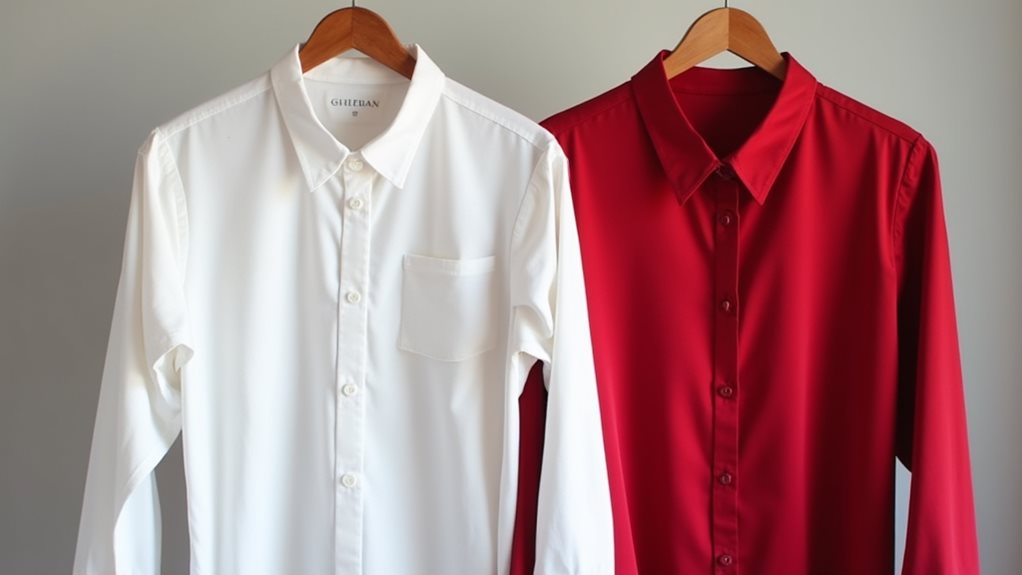
Although I used to think dry cleaning was simply about avoiding water damage, the real magic happens at the molecular level where smart solvent chemistry protects your clothes’ colors in ways that genuinely surprised me.
Here’s what’s actually happening: traditional solvents used in dry cleaning can chemically react with fabric dyes, causing those heartbreaking color shifts you’ve probably experienced.
However, advanced solvents like siloxane work differently—they don’t react with dyes at all, which means zero color bleeding or fading.
You can actually see this science in action by observing the solvent’s clarity; when it stays crystal clear after cleaning, that’s your visual proof that no dye molecules escaped from your garments.
Perchloroethylene (PERC) remains the most widely used solvent in professional dry cleaning operations due to its exceptional ability to dissolve oils and greases without damaging delicate fabrics.
Pretty cool, right?
Common Causes of Color Loss During Cleaning
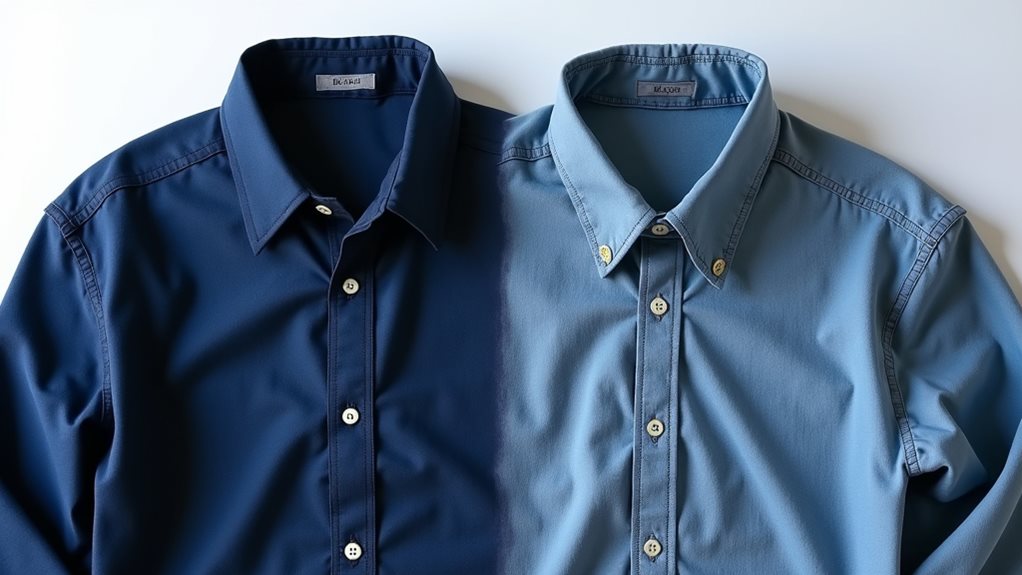
You’ve probably experienced that sinking feeling when you pick up a garment from the cleaners and notice the colors look different, but understanding what causes these mishaps can help you prevent them in the future.
Chemical solvent reactions occur when certain dyes simply can’t handle the cleaning process, much like how my favorite red silk blouse once emerged looking more like a faded pink memory after an unfortunate encounter with the wrong solvent.
Improper cleaning methods, whether it’s using too harsh chemicals or incorrect temperatures, can turn your vibrant wardrobe into a collection of sad, washed-out versions of their former selves.
While dry cleaning uses chemical solvents instead of water to be gentler on fabrics and dyes, it’s important to note that exposure to light and heat during the process can still contribute to color loss over time.
Chemical Solvent Reactions
If you’ve ever pulled a favorite garment from the dry cleaner’s bag only to discover mysterious color changes, you’ve likely encountered the harsh reality of chemical solvent reactions.
About 95% of dry cleaners use solvents that aren’t chemically inert, meaning they can react with your garment’s dyes, causing bleeding, pulling, or fading that’ll make you want to cry 😢.
Here’s what happens when solvents used in dry cleaning go rogue:
- Perchloroethylene (perc) chemically attacks fabric dyes, creating localized color loss
- Chemical reactions occur during cleaning, leading to permanent color damage
- Non-reactive solvents like siloxane preserve garment color by avoiding dye interactions
Color changes can also result from poor-quality dyes that weren’t properly set during the manufacturing process, making them vulnerable to chemical solvents.
To preserve garment color, choose cleaners using fabric-gentle fluids, and always communicate about spills or previous color issues before cleaning.
Improper Cleaning Methods
When I think about the countless garments I’ve seen ruined by well-meaning but misguided cleaning attempts, my heart genuinely aches for both the clothes and their owners who trusted the wrong methods.
You wouldn’t believe how many beautiful pieces I’ve witnessed suffer devastating discoloration simply because someone ignored that vital “dry clean only” label and tossed them into a washing machine instead.
I’ve watched dark cottons fade to sad shadows of their former selves, witnessed delicate silks bleed their vibrant hues across other fabrics, and seen expensive garments transformed into disappointing reminders of what happens when we skip proper care instructions.
These improper cleaning methods don’t just damage clothes—they break hearts and empty wallets unnecessarily.
The truth is that dry cleaning uses specialized solvents and techniques that simply cannot be replicated at home, which is why attempting to wash these delicate items with conventional methods will almost always result in permanent damage.
Why Traditional Washing Can Damage Dark Garments
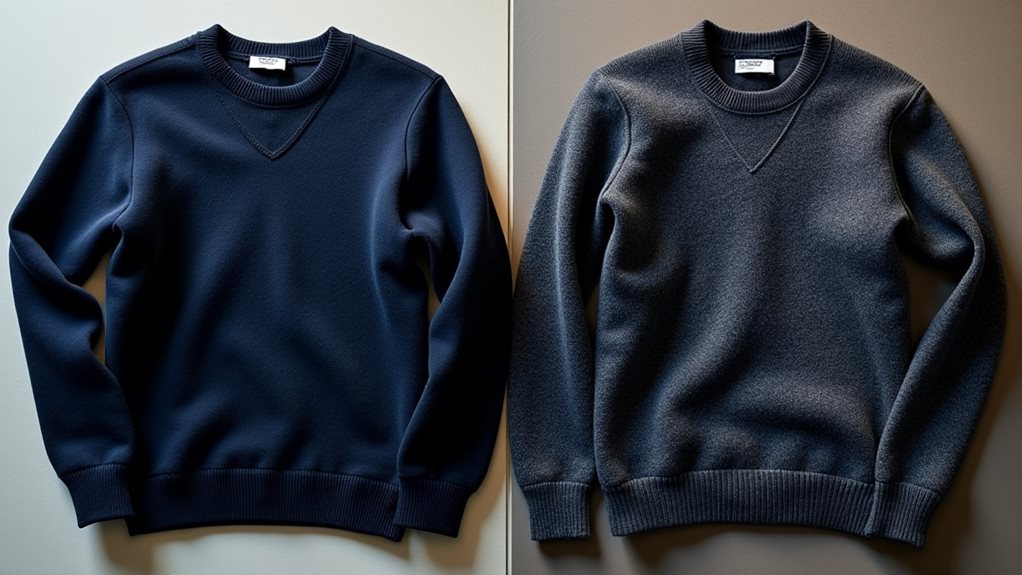
When you toss your favorite black sweater into the washing machine, you’re fundamentally subjecting those precious dye molecules to a triple threat that’ll leave you wondering why your once-vibrant garment now looks like it survived a color apocalypse.
The water acts like a tiny thief, literally pulling dye molecules away from the fabric fibers, while the aggressive spinning and tumbling creates friction that causes colors to bleed out faster than you can say “oops.”
Meanwhile, that hot water you thought would get things extra clean is actually speeding up the entire fading process, because heat makes those dye molecules more unstable and keen to escape – kind of like how I bolt from awkward conversations at family dinners! 😅
This is precisely why chemical solvents used in dry cleaning are so much gentler on your garments, as they eliminate the water-based damage that traditional washing inflicts on fabric dyes.
Water Strips Dye Molecules
Although we’ve been washing clothes with water for centuries, this seemingly harmless liquid actually acts like a tiny molecular thief, quietly stealing the vibrant dyes that make your favorite black dress or navy blazer look so sharp.
When water molecules penetrate fabric fibers, they literally break apart the chemical bonds holding dye particles in place, causing that heartbreaking color loss you’ve probably noticed after washing your favorite dark pieces.
Here’s what happens during traditional washing:
- Water molecules disrupt dye bonds through aggressive molecular interaction
- Agitation accelerates the release of color particles into wash water
- Heat amplifies water damage by making dye molecules more unstable
That’s why dry cleaning becomes your color-preservation superhero, protecting against water damage while keeping your garments looking professionally pristine.
The dry cleaning process uses chemical solvents like perchloroethylene instead of water, which means your delicate fabrics avoid the molecular disruption that causes color bleeding and fading.
Agitation Causes Color Bleeding
While water quietly steals your garment’s dye molecules, the washing machine’s aggressive tumbling and spinning creates an even more destructive force that physically yanks color particles right out of your fabric’s fibers.
Think of agitation like a relentless massage therapist who doesn’t know when to stop – it keeps rubbing and rubbing until your favorite black sweater looks more charcoal gray than midnight.
Dark cottons and linens suffer the most, especially when you’ve misread those tiny care labels (we’ve all been there 🙄). The constant mechanical friction creates uneven color loss, leaving your garments looking tired and faded.
This is precisely why dry cleaning preserves color so effectively – it skips the brutal tumbling altogether, using gentle solvents instead. The specialized cleaning method not only maintains the original vibrancy of your garments but also helps preserve their shape and texture simultaneously.
Heat Accelerates Fading Process
If water and agitation form a destructive duo, heat becomes their ruthless accomplice, turning your washing machine into a color-destroying furnace that breaks down dye molecules at the molecular level.
I’ve watched countless beloved dark jeans transform into sad, washed-out shadows of their former selves because I trusted that “hot” setting one too many times.
Here’s what heat does to your favorite dark garments:
- Destabilizes dye molecules – High temperatures literally shake apart the chemical bonds that keep colors vibrant
- Accelerates shrinkage – Heat causes fibers to contract, creating additional stress that makes colors fade faster
- Creates permanent damage – Unlike gentle stains, heat-induced fading can’t be reversed or restored
Dry cleaning sidesteps this thermal destruction entirely, maintaining stable temperatures that protect your investment pieces. Professional dry cleaning solvents like perchloroethylene provide a gentler alternative to the harsh combination of heat, water, and detergent that traditional washing machines use.
Chemical Reactions Between Solvents and Dyes
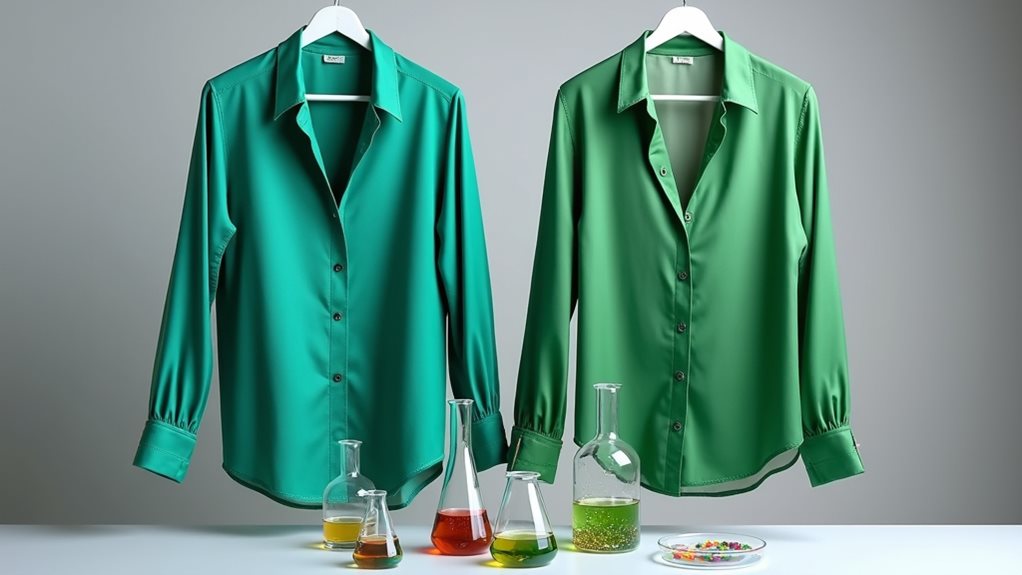
When you drop off your favorite dress at the dry cleaner, you’re probably not thinking about the invisible chemical dance happening between the cleaning solvents and your garment’s dyes.
Behind the scenes at your dry cleaner, an invisible chemical ballet determines whether your favorite garments keep their vibrant colors or fade away.
But trust me, this microscopic tango can make or break your beloved outfit’s vibrant colors.
Here’s what’s really happening: most dry cleaners (about 95%) use solvents like perchloroethylene that aren’t chemically inert, meaning they actually react with your garment dyes, causing bleeding, pulling, or that heartbreaking fade you discover later.
It’s like watching your favorite sweater slowly lose its personality!
The smart move? Look for cleaners using fabric-gentle solvents like siloxane, which won’t chemically react with dyes, keeping your colors intact and your wardrobe happy.
While perchloroethylene has been the industry standard for decades due to its excellent cleaning properties, environmentally conscious dry cleaners are increasingly adopting safer alternatives.
Signs Your Dry Cleaner Uses Quality Solvents

Knowing the chemistry behind solvent-dye reactions is one thing, but spotting the telltale signs that your dry cleaner actually uses quality solvents requires a bit of detective work that’ll save your wardrobe from future heartbreak.
Trust me, I’ve learned this lesson the hard way after watching my favorite black blazer turn an unfortunate shade of charcoal gray 😅.
Here’s what to look for when evaluating your cleaning provider:
- Crystal-clear solvents – Quality dry cleaning facilities maintain pristine, colorless fluids rather than murky, discolored solutions that scream “dye extraction in progress”
- Questions about solvent types – Professional cleaners should readily discuss their chemical processes, particularly whether they use chemically inert options like siloxane
- Vibrant garment returns – Your clothes should emerge looking refreshed, not faded or dulled from inferior solvents used in dry cleaning operations
Best Practices for Maintaining Vibrant Colors

While choosing the right dry cleaner sets the foundation for color preservation, maintaining those vibrant hues requires a partnership between professional expertise and your daily garment care habits.
I learned this lesson after watching my favorite navy blazer fade from neglecting simple care routines 😅.
First, always follow care labels religiously—those “dry clean only” tags aren’t suggestions, they’re lifelines that prevent color stripping.
Second, treat spills immediately before they set and require harsh removal methods.
Store your garments in cool, dark closets away from sunlight, which can bleach even the most stubborn dyes.
Choosing the Right Cleaning Method for Color-Sensitive Fabrics
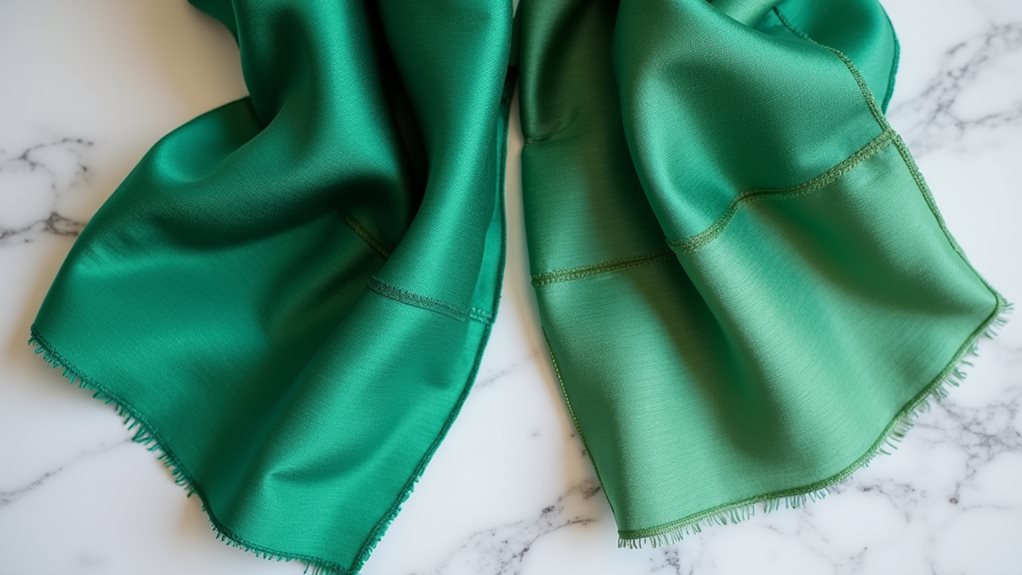
How do you know which cleaning method will truly protect your most treasured, color-sensitive fabrics without turning them into expensive mistakes?
I’ve learned this lesson the hard way after ruining my favorite silk blouse because I ignored the care label 😅.
Here’s your roadmap for making smart cleaning choices:
- Check care labels religiously – “dry clean only” means exactly that, no exceptions or shortcuts.
- Identify fabric types – silk, wool, and delicate synthetics almost always need professional dry cleaning.
- Consider the garment’s value – expensive pieces deserve the gentle treatment that non-water solvents provide.
The truth is, dry cleaning uses specialized solvents that won’t cause color bleeding or fading like water-based cleaning methods.
When you’re dealing with color-sensitive fabrics, this gentle approach preserves vibrancy while extending your garment’s lifespan considerably.




